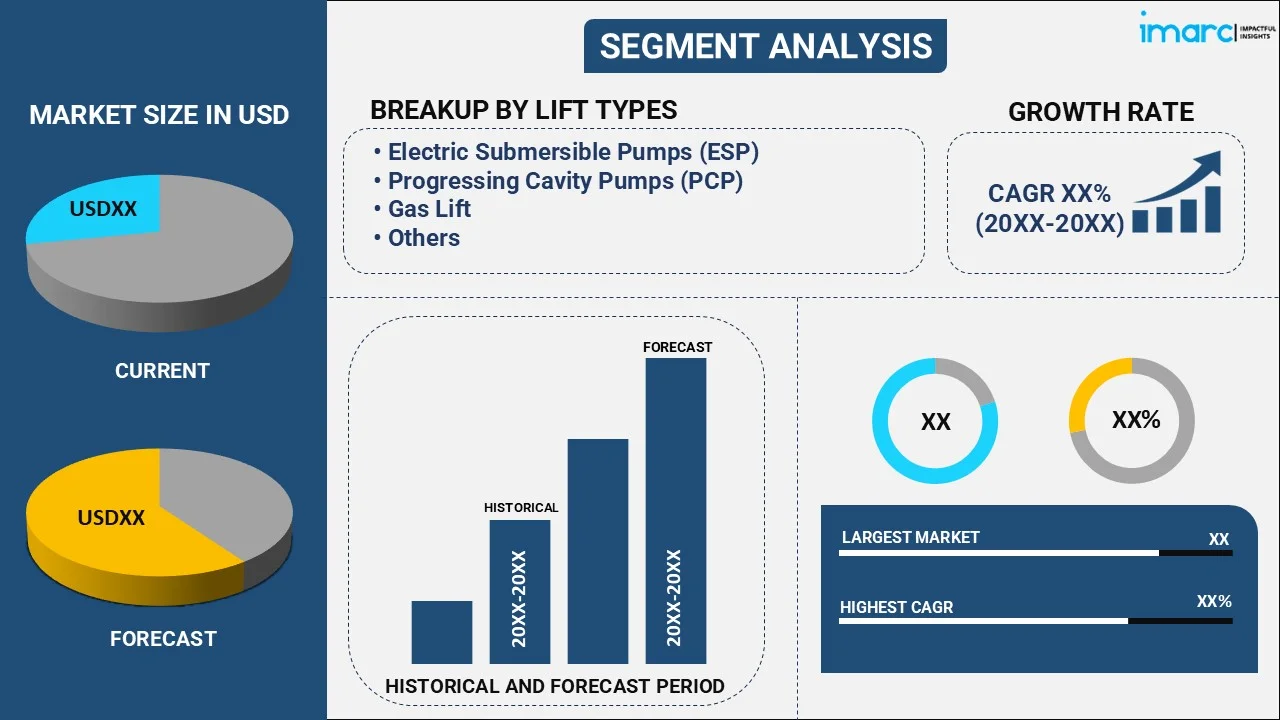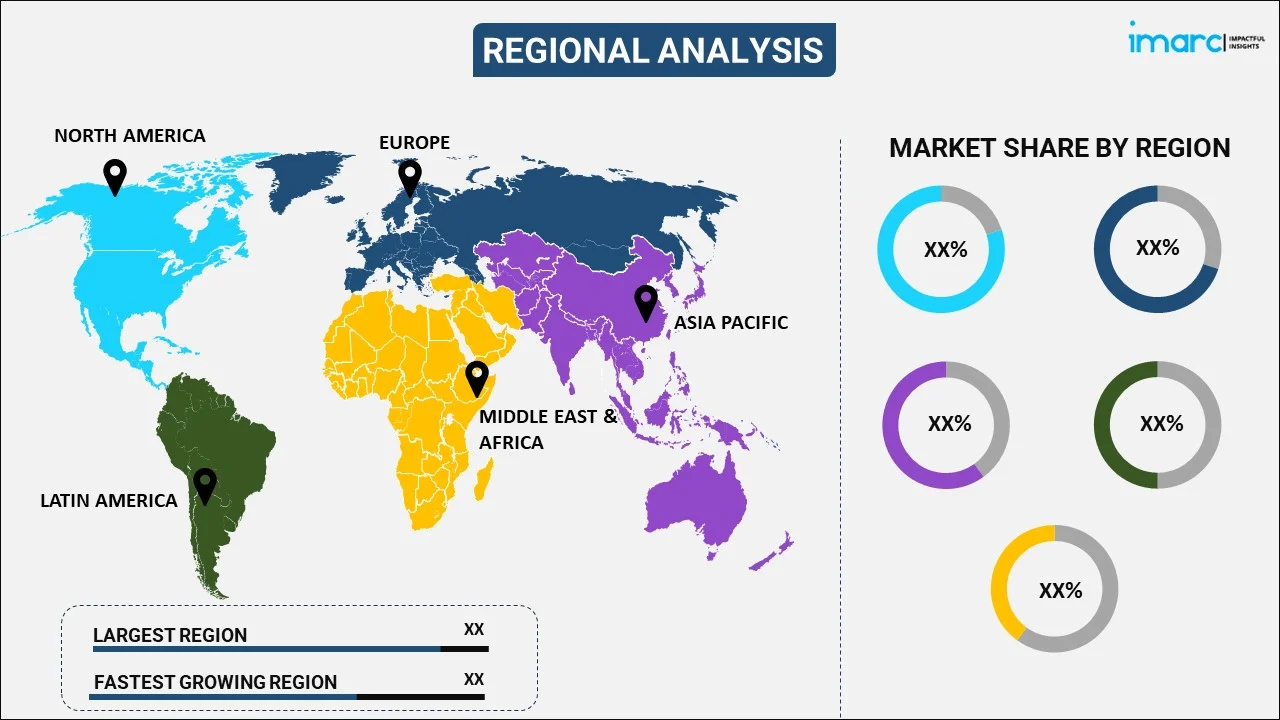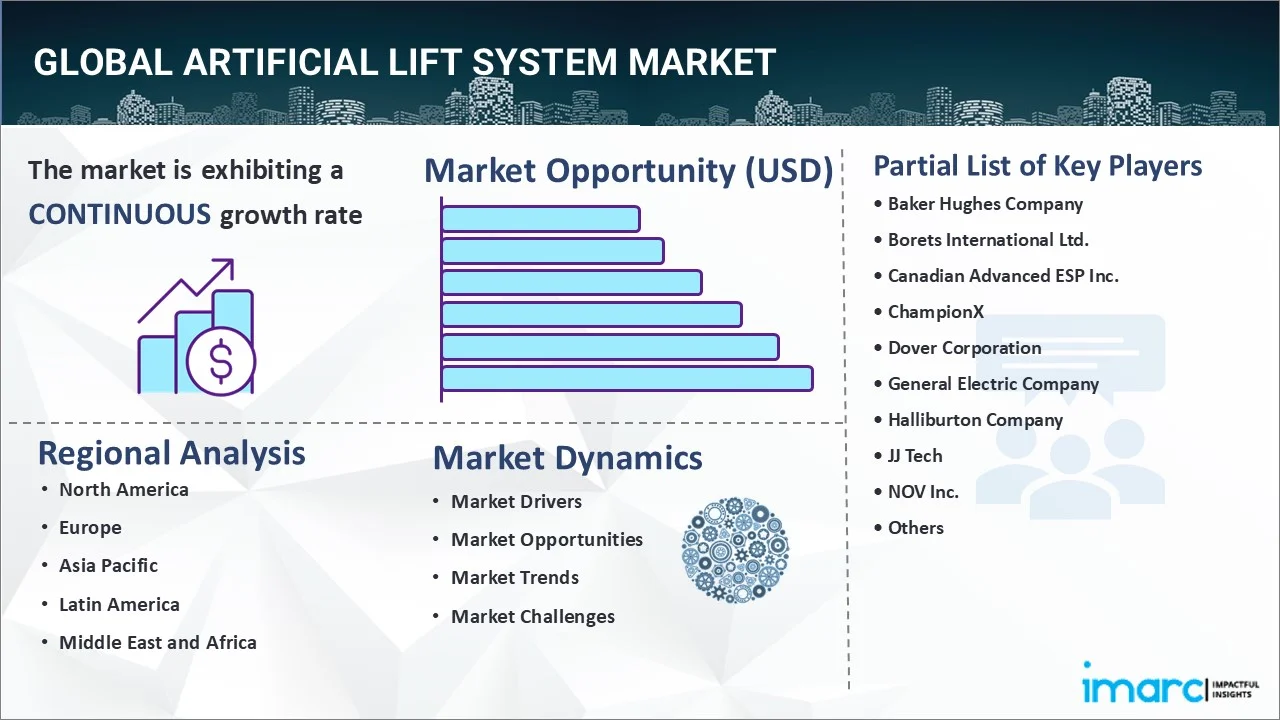
Artificial Lift System Market Report by Lift Type (Electric Submersible Pumps (ESP), Progressing Cavity Pumps (PCP), Gas Lift, Rod Lift, Hydraulic Pumps, and Others), Well Type (Horizontal, Vertical), Mechanism (Gas Assisted, Pump Assisted), Application (Offshore, Onshore), and Region 2025-2033
Global Artificial Lift System Market:
The global artificial lift system market size reached USD 24.3 Billion in 2024. Looking forward, IMARC Group expects the market to reach USD 37.0 Billion by 2033, exhibiting a growth rate (CAGR) of 4.52% during 2025-2033. The decline in natural reservoir pressure owing to aging oil and gas wells, rising global energy demand, escalating environmental and cost concerns, and continuous technological advancements in artificial lift systems are some of the major factors propelling the market.
|
Report Attribute
|
Key Statistics
|
|---|---|
|
Base Year
|
2024
|
|
Forecast Years
|
2025-2033
|
|
Historical Years
|
2019-2024
|
|
Market Size in 2024
|
USD 24.3 Billion |
|
Market Forecast in 2033
|
USD 37.0 Billion |
| Market Growth Rate 2025-2033 | 4.52% |
Artificial Lift System Market Analysis:
- Major Market Drivers: The escalating energy demand globally, coupled with the aging oil and gas wells, are stimulating the growth of the artificial lift system. Moreover, environmental considerations are gaining prominence as stricter regulations push the oil and gas industry toward more sustainable practices, further propelling the adoption of artificial lift systems.
- Key Market Trends: The growing focus on maximizing the recovery of existing reserves instead of exploring new sites owing to environmental and cost concerns, is further expected to stimulate the artificial lift system demand. Moreover, geopolitical factors, such as stability in key oil-producing regions, are positively influencing market growth as they allow for sustained investment in extraction technologies, including artificial lift systems.
- Competitive Landscape: Some of the prominent companies in the market include Baker Hughes Company, Borets International Ltd., Canadian Advanced ESP Inc., ChampionX, Dover Corporation, General Electric Company, Halliburton Company, JJ Tech, NOV Inc., Schlumberger Limited, Tenaris S.A. (Techint), and Weatherford International plc., among many others.
- Geographical Trends: According to the artificial lift system market dynamics, North America exhibits a clear dominance in the market. The region, particularly the United States, has been at the forefront of shale oil and gas production. The development of unconventional resources, such as shale gas reserves, requires efficient artificial lift systems to maximize production from horizontal wells and complex reservoirs.
- Challenges and Opportunities: High initial costs and rising environmental concerns are hampering the market growth. However, continuous advancements in materials, sensors, and automation technologies improve system efficiency, reliability, and safety, offering competitive advantages.
Artificial Lift System Market Trends:
Increasing Oil and Gas Production
As global energy demand continues to rise, there is a growing need to maximize production from existing oil and gas wells. For instance, according to the IEA (India Energy Outlook 2021), primary energy demand was predicted to nearly double to 1,100 million tons of oil equivalent. Governments across various economies are also taking initiatives to propel the gas sector. For instance, in February 2024, the Prime Minister of India launched a US$ 67 Billion strategic investment plan for the Indian gas sector for over next 5–6 years. Artificial lift systems help maintain or enhance production rates by overcoming reservoir pressure decline. These factors are further contributing to the artificial lift system market share.
Growing Drilling Activities
As more wells are drilled, particularly in mature fields or unconventional reservoirs (such as shale), there is a growing need for artificial lift systems to optimize production rates and ensure economic viability. For instance, according to Statista, in 2017, an estimated 16,900 oil and gas wells were drilled in the United States, with a total of nearly 22,600 expected by 2022. Moreover, advances in drilling technologies often go hand-in-hand with improvements in artificial lift systems. This synergy drives innovation in artificial lift technologies, making them more efficient, reliable, and cost-effective. These factors are further positively influencing the artificial lift system industry forecast.
Technological Advancements
Modern well control technologies enable more precise monitoring of well conditions, including pressure, temperature, and fluid characteristics. For instance, in October 2023, AIQ and Halliburton partnered with ADNOC to successfully launch RoboWell, an AI-enabled Autonomous Well Control technology, across the energy giant's North East Bab (NEB) site in Abu Dhabi, UAE. This data allows artificial lift systems to operate more efficiently and adaptively, optimizing production rates and reducing downtime. This is further bolstering the artificial lift system market revenue.
Global Artificial Lift System Industry Segmentation:
IMARC Group provides an analysis of the key trends in each segment of the market report, along with forecasts at the global, regional, and country levels from 2025-2033. Our report has categorized the market based on lift type, well type, mechanism and application.
Breakup by Lift Type:

- Electric Submersible Pumps (ESP)
- Progressing Cavity Pumps (PCP)
- Gas Lift
- Rod Lift
- Hydraulic Pumps
- Others
Electric Submersible Pumps (ESP) dominate the market
The report has provided a detailed breakup and analysis of the market based on the lift type. This includes electric submersible pumps (ESP), progressing cavity pumps (PCP), gas lift, rod lift, hydraulic pumps, and others. According to the report, electric submersible pumps (ESP) represented the largest segment.
According to the artificial lift system market outlook, electric submersible pumps (ESP) offer high volumetric efficiency, capable of handling a wide range of flow rates, from low to exceptionally high. This makes them highly adaptable to various reservoir conditions and operational requirements. Moreover, ESPs are known for their energy efficiency, which leads to lower operating costs over time. The electric operation eliminates the need for surface-level pumping units, thereby reducing both the surface footprint and mechanical losses. Besides this, ESPs are exceptionally versatile and can be employed in different settings, including offshore, onshore, and even in deviated or horizontal wells. This adaptability expands their applicability across a diverse range of reservoirs and geological conditions. For instance, in April 2024, SLB launched two revolutionary artificial lift systems, the Reda Agile compact wide-range electric submersible pump (ESP) system and the rodless Reda PowerEdge electric submersible progressive cavity pump (ESPCP) system, which provide continuous live surveillance and real-time optimization.
Breakup by Well Type:
- Horizontal
- Vertical
Horizontal represents the most popular well type
A detailed breakup and analysis of the market based on the well type has also been provided in the report. This includes horizontal and vertical. According to the report, horizontal accounted for the largest market share.
According to the artificial lift system market overview, horizontal drilling provides a greater contact area with the production reservoir compared to traditional vertical wells. This higher exposure significantly enhances the flow rates of hydrocarbons, making the extraction process more efficient. Furthermore, horizontal wells are particularly effective in the extraction of unconventional resources like shale gas and tight oil formations. They enable the optimization of hydraulic fracturing, a technique often essential for liberating hydrocarbons in these low-permeability reservoirs. Also, horizontal wells offer environmental benefits, as fewer wellheads are required to access the same volume of resources. This reduced surface footprint minimizes the environmental impact and makes land reclamation easier post-production.
Breakup by Mechanism:
- Gas Assisted
- Pump Assisted
Gas assisted mechanism holds the largest share in the market
The report has provided a detailed breakup and analysis of the market based on the mechanism. This includes gas assisted and pump assisted. According to the report, gas assisted represented the largest segment.
Gas-assisted lift systems offer unparalleled flexibility in terms of their adaptability to fluctuating well conditions and production rates. They are capable of handling both low and high volumes of liquid, making them suitable for a variety of reservoir scenarios. Apart from this, gas lift systems are particularly efficient for wells that produce a significant amount of associated gas. Utilizing this naturally occurring gas can substantially reduce operational costs and enhance overall system efficiency. Moreover, gas-assisted lifts are relatively easy to install and require fewer mechanical parts compared to other artificial lift methods, such as electric submersible pumps (esps) or rod lifts. This simplicity translates to lower maintenance requirements and operational downtime, further driving down total cost of ownership.
Breakup by Application:
- Offshore
- Onshore
Offshore accounts for the majority of the market share
A detailed breakup and analysis of the market based on the application have also been provided in the report. This includes offshore and onshore. According to the report, offshore accounted for the largest market share.
Offshore reservoirs often contain significant volumes of high-value hydrocarbons, making it economically justifiable to invest in advanced artificial lift technologies to maximize production. These fields generally have a longer production life, which makes the initial investment in artificial lift systems more cost-effective over the long term. The challenging conditions in offshore environments, such as high pressures and corrosive seawater, necessitate the use of robust and reliable artificial lift methods. These systems are engineered to meet the specific demands of offshore operations, ensuring durability and efficiency.
Breakup by Region:

- North America
- United States
- Canada
- Asia-Pacific
- China
- Japan
- India
- South Korea
- Australia
- Indonesia
- Others
- Europe
- Germany
- France
- United Kingdom
- Italy
- Spain
- Russia
- Others
- Latin America
- Brazil
- Mexico
- Others
- Middle East and Africa
North America exhibits a clear dominance in the market
The market research report has also provided a comprehensive analysis of all the major regional markets, which include North America (the United States and Canada); Asia-Pacific (China, Japan, India, South Korea, Australia, Indonesia, and others); Europe (Germany, France, the United Kingdom, Italy, Spain, Russia, and others); Latin America (Brazil, Mexico, and others); and the Middle East and Africa. According to the report, North America accounted for the largest market share.
According to the artificial lift system market statistics, North America held the biggest market share since the region has a mature oil and gas industry with a large number of aging wells that require artificial lift systems to maintain production levels. The declining natural pressure in these wells makes the use of artificial lift methods increasingly indispensable for continued operation. Furthermore, North America is a global leader in the extraction of unconventional resources, such as shale gas and tight oil. The extraction of these resources often necessitates the use of advanced artificial lift technologies, thus spurring the demand. The region also boasts strong technological capabilities and infrastructure, which facilitates the development and adoption of innovative artificial lift solutions. Research and development are robust, supported by significant investments from both private and public sectors. For instance, in June 2021, Oil Dynamics GmbH updated two wells for an oilfield operator who wanted to renew and improve pumping equipment at its site near Hannover, Germany. Oil Dynamics changed the wells from Progressive Cavity Pumps (PCPs) to Electric Submersible Pumps (ESPs). Investment in modernizing oil fields is projected to boost industry growth.
Competitive Landscape:
The market is experiencing moderate growth as key players in the artificial lift systems industry are actively engaging in a range of strategic initiatives to consolidate their market positions. They are investing heavily in research and development (R&D) to introduce technologically advanced and more efficient lift systems, aiming to cater to a broader range of well conditions and operational requirements. Collaborations, partnerships, and mergers and acquisitions are also commonplace, as companies seek to expand their product portfolios and geographical reach. Additionally, these industry leaders are increasingly focusing on incorporating digital technologies like real-time monitoring, data analytics, and machine learning to enhance the efficiency and reliability of their artificial lift systems. Through these actions, key players are striving to meet the evolving needs of the oil and gas industry while sustaining a competitive advantage.
The market research report has provided a comprehensive analysis of the competitive landscape. Detailed profiles of all major companies have also been provided. Some of the key players in the market include:
- Baker Hughes Company
- Borets International Ltd.
- Canadian Advanced ESP Inc.
- ChampionX
- Dover Corporation
- General Electric Company
- Halliburton Company
- JJ Tech
- NOV Inc.
- Schlumberger Limited
- Tenaris S.A. (Techint)
- Weatherford International plc
(Please note that this is only a partial list of the key players, and the complete list is provided in the report.)
Artificial Lift System Market Recent Developments:
- April 2024: SLB launched two revolutionary artificial lift systems, the Reda Agile compact wide-range electric submersible pump (ESP) system and the rodless Reda PowerEdge electric submersible progressive cavity pump (ESPCP) system.
- February 2024: ChampionX Corp, an oilfield technology and services firm, acquired Artificial Lift Performance Limited (ALP), which provides analytics solutions to improve oil and gas production performance.
- October 2023: AIQ and Halliburton partnered with ADNOC to successfully launch RoboWell, an AI-enabled Autonomous Well Control technology.
Artificial Lift System Market Report Scope:
| Report Features | Details |
|---|---|
| Base Year of the Analysis | 2024 |
| Historical Period | 2019-2024 |
| Forecast Period | 2025-2033 |
| Units | Billion USD |
| Scope of the Report | Exploration of Historical Trends and Market Outlook, Industry Catalysts and Challenges, Segment-Wise Historical and Predictive Market Assessment:
|
| Lift Types Covered | Electric Submersible Pumps (ESP), Progressing Cavity Pumps (PCP), Gas Lift, Rod Lift, Hydraulic Pumps, Others |
| Well Types Covered | Horizontal, Vertical |
| Mechanisms Covered | Gas Assisted, Pump Assisted |
| Applications Covered | Offshore, Onshore |
| Regions Covered | Asia Pacific, Europe, North America, Latin America, Middle East and Africa |
| Countries Covered | United States, Canada, Germany, France, United Kingdom, Italy, Spain, Russia, China, Japan, India, South Korea, Australia, Indonesia, Brazil, Mexico |
| Companies Covered | Baker Hughes Company, Borets International Ltd., Canadian Advanced ESP Inc., ChampionX, Dover Corporation, General Electric Company, Halliburton Company, JJ Tech, NOV Inc., Schlumberger Limited, Tenaris S.A. (Techint), Weatherford International plc., etc. |
| Customization Scope | 10% Free Customization |
| Post-Sale Analyst Support | 10-12 Weeks |
| Delivery Format | PDF and Excel through Email (We can also provide the editable version of the report in PPT/Word format on special request) |
Key Benefits for Stakeholders:
- IMARC's report offers a comprehensive quantitative analysis of various market segments, historical and current market trends, market forecasts, and dynamics of the artificial lift system market from 2019-2033.
- The research study provides the latest information on the market drivers, challenges, and opportunities in the global artificial lift system market.
- The study maps the leading, as well as the fastest-growing, regional markets. It further enables stakeholders to identify the key country-level markets within each region.
- Porter's five forces analysis assists stakeholders in assessing the impact of new entrants, competitive rivalry, supplier power, buyer power, and the threat of substitution. It helps stakeholders to analyze the level of competition within the artificial lift system industry and its attractiveness.
- The competitive landscape allows stakeholders to understand their competitive environment and provides insight into the current positions of key players in the market.
Key Questions Answered in This Report
The artificial lift system market was valued at USD 24.3 Billion in 2024.
The artificial lift system market is projected to exhibit a CAGR of 4.52% during 2025-2033.
Key factors driving the artificial lift system market include rising global energy demand, depletion of mature oil fields, and advancements in oil extraction technologies. The increasing need for efficient hydrocarbon recovery, growing investments in upstream oil and gas activities, and rising offshore exploration also fuel market growth.
North America currently dominates the market, driven by the region’s mature oil and gas industry with a large number of aging wells that require artificial lift systems to maintain production levels.
Some of the major players in the artificial lift system market include Baker Hughes Company, Borets International Ltd., Canadian Advanced ESP Inc., ChampionX, Dover Corporation, General Electric Company, Halliburton Company, JJ Tech, NOV Inc., Schlumberger Limited, Tenaris S.A. (Techint), Weatherford International plc., etc.
Need more help?
- Speak to our experienced analysts for insights on the current market scenarios.
- Include additional segments and countries to customize the report as per your requirement.
- Gain an unparalleled competitive advantage in your domain by understanding how to utilize the report and positively impacting your operations and revenue.
- For further assistance, please connect with our analysts.

 Request Customization
Request Customization
 Speak to an Analyst
Speak to an Analyst
 Request Brochure
Request Brochure
 Inquire Before Buying
Inquire Before Buying




.webp)




.webp)












